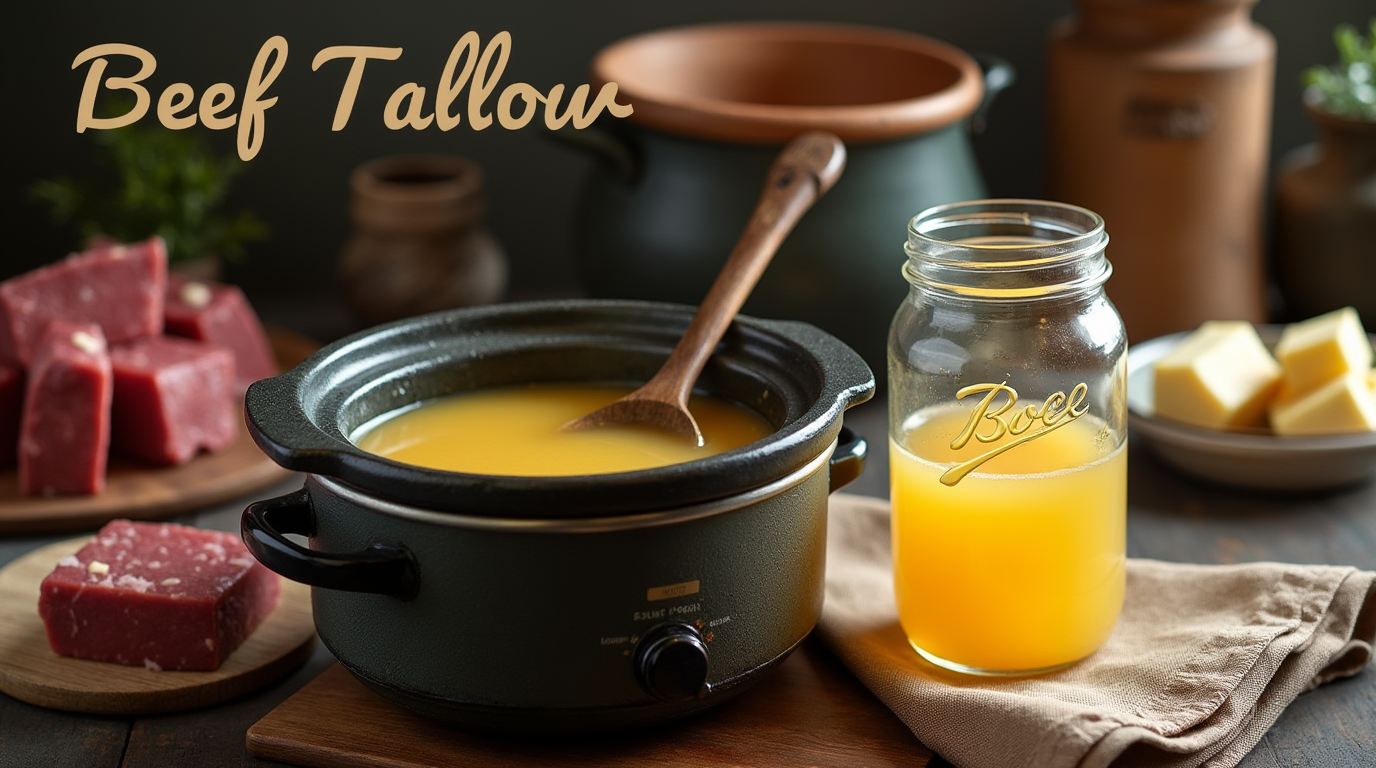Introduction
Beef tallow is a highly versatile cooking fat that has been used for centuries in kitchens around the world. It is derived from rendered beef fat and is prized for its high smoke point, long shelf life, and rich flavor. Whether you’re looking to make beef tallow biscuits, fry foods in homemade beef tallow, or use it as an ingredient in skincare products, learning how to render beef tallow at home is a valuable skill. Using a crockpot makes the process easy and hands-free, ensuring a pure and high-quality product.
In this comprehensive guide, we’ll explore how to render beef fat for tallow using a slow cooker, methods for canning beef tallow, and creative ways to incorporate it into your cooking. By the end of this article, you’ll be ready to make and use homemade beef tallow with confidence.
What is Beef Tallow?
Beef tallow is rendered beef fat that has been melted and purified to remove impurities. It solidifies at room temperature, much like butter, and is a stable fat perfect for high-heat cooking. Traditional methods for rendering beef tallow involve stovetop simmering, but using a slow cooker is a simple, mess-free alternative.
Benefits of Using Beef Tallow
- High smoke point: Perfect for frying, roasting, and sautéing.
- Rich in nutrients: Contains fat-soluble vitamins like A, D, E, and K.
- Long shelf life: Properly stored tallow lasts for months without refrigeration.
- Versatile use: Ideal for cooking with beef tallow, making candles, soaps, and skincare products.
Ingredients and Equipment
Ingrédients
- 2-4 lbs of beef fat (suet or trimmed fat from beef cuts)
- ½ cup water (optional, to prevent initial burning)
Equipment
- Slow cooker (crockpot)
- Sharp knife or food processor for chopping fat
- Fine-mesh strainer or cheesecloth
- Glass jars or airtight containers (for storage and canning beef tallow)

How to Render Beef Fat for Tallow in a Slow Cooker
Step 1: Prepare the Beef Fat
- Trim any remaining meat or connective tissue from the fat.
- Cut the fat into small chunks or use a food processor to pulse it into fine pieces. The smaller the fat pieces, the more efficient the rendering process.
Step 2: Start the Slow Cooker
- Place the fat into the slow cooker.
- Add ½ cup of water (optional) to prevent burning before the fat begins to melt.
- Set the slow cooker on low heat and cover with the lid.
Step 3: Let the Fat Render
- Allow the fat to render for 6 to 10 hours, stirring occasionally.
- As the fat melts, it will separate into liquid tallow and leftover crispy bits known as cracklings.
- The rendering is complete when the fat is fully melted and the cracklings are golden brown.
Step 4: Strain the Tallow
- Line a fine-mesh strainer with cheesecloth and place it over a heat-proof bowl or glass jar.
- Carefully pour the hot liquid through the strainer to remove any solid bits.
- Let the strained tallow cool at room temperature.
Step 5: Store the Tallow
- Once cooled, the homemade beef tallow will turn solid and white.
- Store in glass jars ou airtight containers.
- For long-term storage, consider canning beef tallow using sterilized jars and lids.
- Tallow can be stored in the pantry for up to 6 months or in the refrigerator for up to 1 year.

How to Use Beef Tallow
1. Cooking and Baking
- Use tallow for frying, roasting, and making beef tallow biscuits.
- Replace butter or vegetable oils in recipes for a rich, beefy flavor.
2. Making Homemade Soaps and Candles
- Beef tallow is an excellent base for natural soaps and long-burning candles.
3. Skincare Applications
- Apply tallow as a moisturizer for dry skin, or mix it with essential oils for a homemade balm.
4. Traditional Uses
- Historically, tallow was used for preserving food, seasoning cast iron, and even lubricating machinery.
Canning Beef Tallow for Long-Term Storage
If you want to store tallow for years, canning is a great option.
Steps for Canning Beef Tallow:
- Sterilize jars by boiling them for 10 minutes.
- Pour hot, strained tallow into jars, leaving ½-inch headspace.
- Seal with sterilized lids and allow to cool at room temperature.
- Store in a cool, dark place.
Common Questions About Rendering Tallow in a Slow Cooker
Can I Render Tallow Without a Slow Cooker?
Yes! Tallow can be rendered on a stovetop or in an oven. However, a crockpot makes the process easier and reduces the risk of burning the fat.
What’s the Difference Between Suet and Beef Fat?
- Suet is the fat surrounding a cow’s kidneys and is the highest-quality fat for making tallow.
- Regular beef fat comes from trimmings and can also be rendered.
Does Beef Tallow Need Refrigeration?
Tallow is shelf-stable but storing it in the fridge or freezer extends its freshness.
What Can I Do with Leftover Cracklings?
Cracklings are crispy, flavorful, and can be eaten as a snack or used as a salad topping.
Réflexions Finales
Learning how to render beef tallow in a slow cooker is a simple and rewarding process. Whether you’re interested in cooking with beef tallow, making beef tallow biscuits, or exploring creative ways to use this nutrient-rich fat, homemade tallow is a great addition to any kitchen. By following this step-by-step guide, you’ll have a clean, high-quality tallow that’s perfect for all your needs.
Now that you know how to make beef tallow at home, try using it in your favorite recipes, skincare, or even for canning beef tallow to enjoy it for years to come!
Keywords: Beef Tallow Biscuits, Render Beef Tallow Crockpot, Canning Beef Tallow, How To Use Beef Tallow, Rendering Beef Tallow, Render Tallow Crock Pot, How To Render Beef Fat For Tallow, Cooking With Beef Tallow, Homemade Beef Tallow


